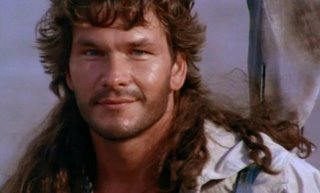Steel Dawn

Sand, who really likes it? That antiquity of erosion, the granulated surface of the earth, rarely is it sentimentalised. Fond kudos and bouncy exaltations are seemingly never vomited out towards that arid material. For the most part sand is viewed as the dry banality that it is. Anakin Skywalker certainly didn’t enjoy its drab texture. The various families savaged by Craven and then Aja will be unlikely to have happy emotions about the stuff. Even though holiday-makers are well known to masturbate convention and lounge about on the shores of some azure wetness, they nevertheless tend to lie on reassuring mats, while scorning the weathering below. But Patrick Swayze, now that is a different matter.
Sand occupies the opening shots of Steel Dawn. And the shots after that. And those dollied shots after that too. In fact most of the cinematography here blinds itself on some acute obsession with sandiness. But that’s ok, because here we have The Swayze. He doesn’t mind irritating grains between the digits, or the occasional friction burn dished out on a heel or two. He plays a nameless nomad who would be right at home visiting the lumpy plains of Tatooine, or that mad antipodean outback that Gibson used to frequent.
This nomad wanders around a desert-laden post-apocalyptic barren land, mullet flowing in the wind, and probably some sorta salsa music on his iPod. He eventually comes to a remnant of civilisation, a small farm, an Owen Lars reject, populated by a big-haired female, her pre-teen son, and some male manual labourers. Noticing the intricate patterns in Swayze’s mullet, they take him in and get him to work in trying to turn this dull wasteland into something that might spew out a leek, or perhaps a cabbage. But it turns out there are some bad plunderers in the area who want the farmland for themselves, sensing that it could benefit their own lust for liquid pleasures. Their acuity certainly isn’t amiss, for the farmland sits atop something resembling a reservoir of fresh water. Swayze is of course dragged into this sorry ordeal, and must defend the farm and defeat his newly acquired nemeses.
Swayze is on fine form here as the quiet hero, lying somewhere between the wrist-slashingly monotonous turn of Kurt Russell in Soldier, and Van Damme’s reanimated
Also featuring in the thespian line-up here is the late great Brion James. A familiar face shifted anonymous all too often by most people, including myself. How could we miss his pivotal role in Men In White, or his slapstick antics in Crimewave? Or, and this is the most revelatory, his career defining turn as Jeff Fahey’s chief in The Underground? The answers are wrapped up in ambiguity, and are unlikely to be unleashed this side of Ted Raimi’s third Oscar.
And Steel Dawn shines its early sun in our eyes once again by gifting us an antediluvian role of Arnold Vosloo, an actor best known for playing Liam Nesson in the Darkman sequels. He scuttles about as a peon henchman named Makker, who eventually gets a knifing from our nomadic warrior.
The film leeches of its influences with a swift gait, ducking behind Lucas just long enough to swipe a concept from Mad Max, while also reaching its hairy knuckles into the somatic recesses of Roddy McDowall and co. It does precede Bruce Campbell’s 1990 sci-fi outing of Mindwarp, although the latter has more underground mutants and chin. Still, who would dare blazon plagiarism when such fine mullets are in procession across the vacuous landscapes? Or who would dare imply larceny when everything is steeped in more soft-focus than a Shannon Tweed movie? Who? No one, that’s right.
Steel Dawn’s finishing dollops are added by the expansive score by Brian May, stressing each flick of follicle with an underlying orchestral accompaniment. Alas, as I was sore to learn post-film, it is not the bouffant May we all know and love, but some jobbing composer. How I feel scenes would have been much enhanced by some harmonic guitar riffing! Maybe Stone Cold Crazy could have played during Swayze’s five minute walk through the desert to save our matriarch. Or Bicycle as some ironic juxtaposition of aural and visual during Swayze’s first twenty minute amble.
Steel Dawn packs in so much sand as to be positively engulfed in the substance, there’s barely any space to fit all the necessary steel and dawn into its 96 minutes of life. Luckily Swayze excelled in the sandpit whilst a youth, and is therefore able to balance the trinity of sand, steel and dawn with little arduousness. This metallic morning puts Jake Lloyd’s loitering about waiting for that menacing phantom to supreme shame. It even includes a precursor to pod-racing, and a young blonde male who proves himself to be a hefty iota or two less annoying than that bowl-haired centrepiece. George Lucas is a vengeful plagiariser.


0 Comments:
Post a Comment
<< Home